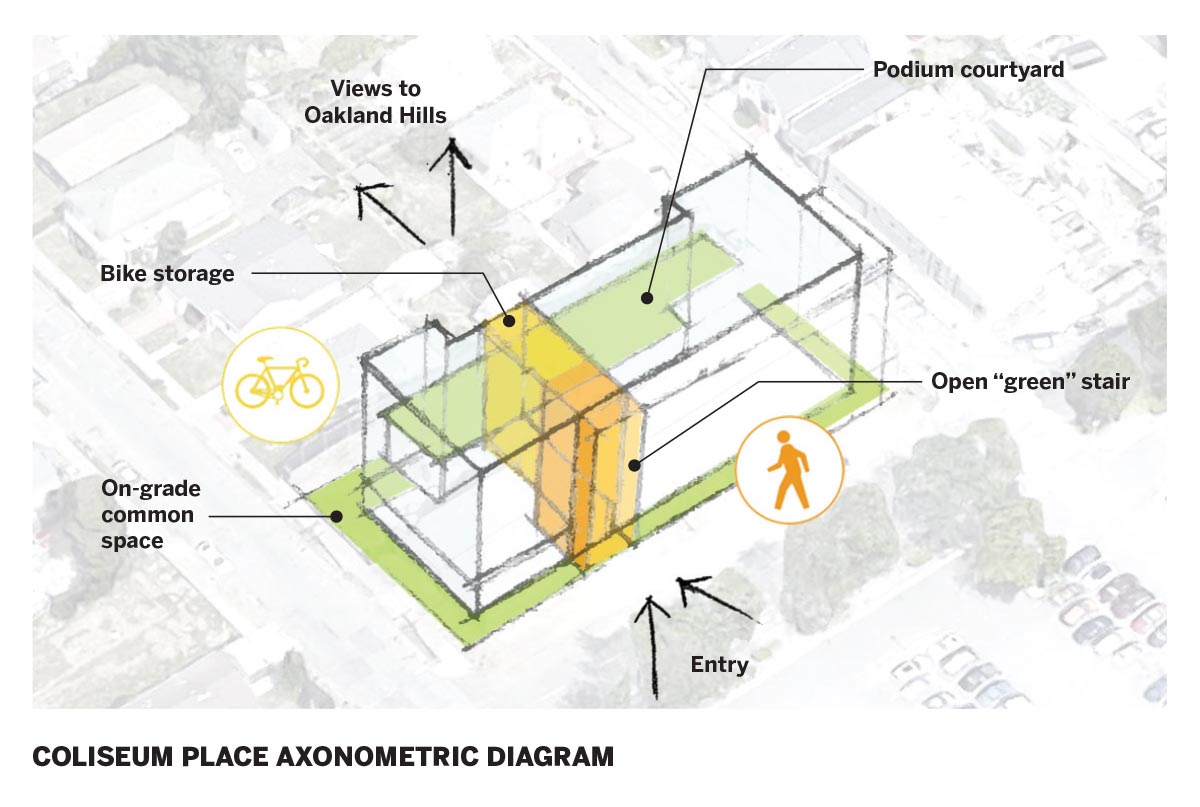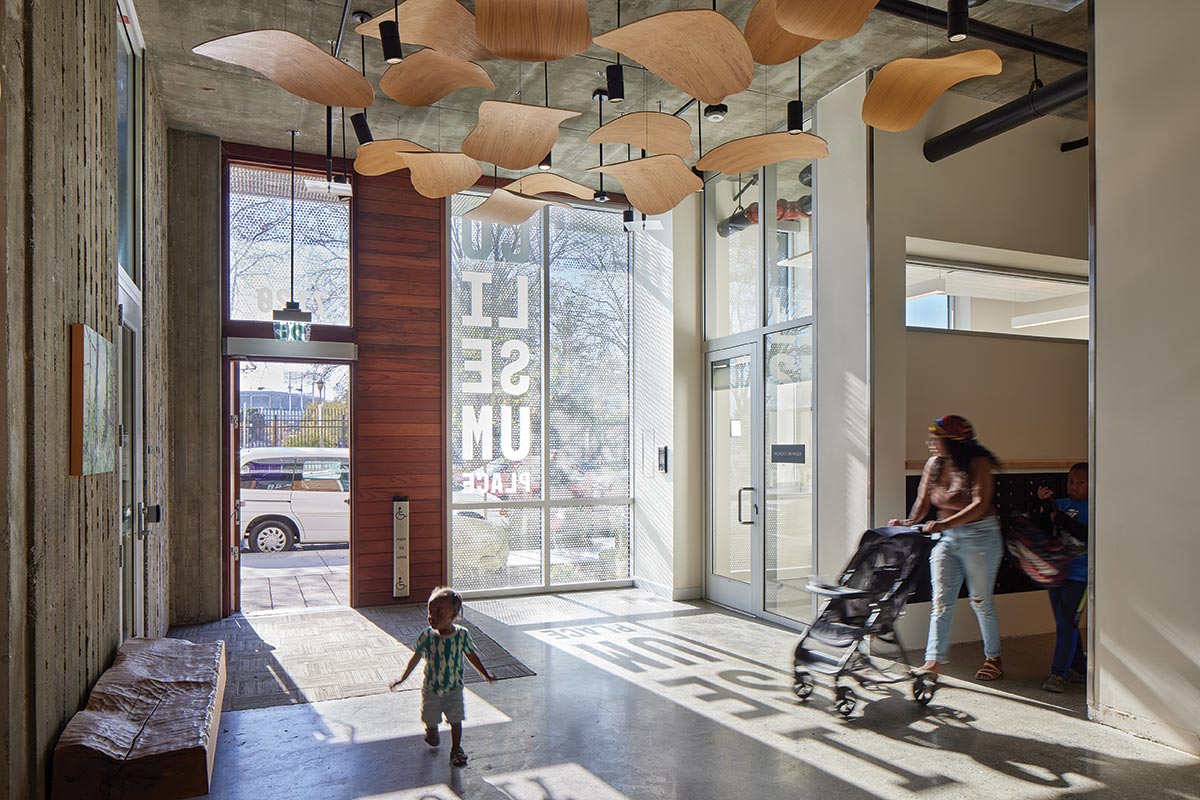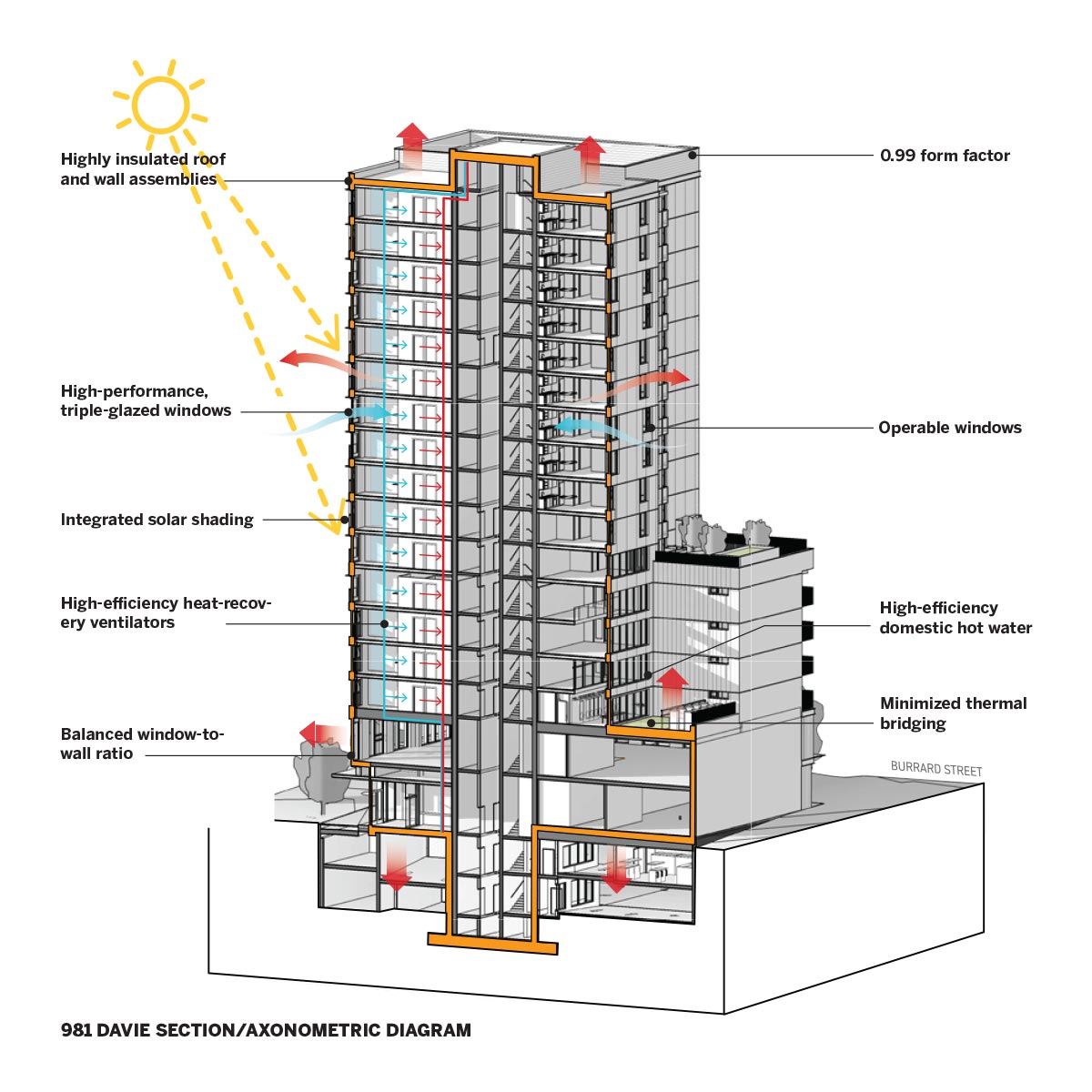Affordable Housing & Energy Performance
Built for construction costs of about $500,000 a unit—“which was pretty typical and pretty alarming at the time,” Ackerly says, “and now of course costs in this market are even higher”—Coliseum Place consists of a simple stepped massing wrapped in a shade screen. A bamboo-filled exterior staircase connects common amenities, fosters active uses and social interaction, and provides both a close-up with nature and expansive views to San Francisco and the East Bay Hills. Rooftop photovoltaics supply the annual energy needs of common areas in the all-electric building. Decentralized heat pumps reduce domestic hot-water energy loads by about 40 percent compared to a conventional central water heater. And air-conditioning and air filtration improve resilience in the face of increasingly hot and smoke-filled seasons.

COURTESY DBA

IMAGE: © BRUCE DAMONTE
Rooftop photovoltaics meet the energy needs of common areas, such as the lobby.
In line with the pilot’s ambition of reducing negative health impacts, both for residents and for workers, DBA specified toxin- and plastic-free interior finishes; however, in what Ackerly calls “a value-engineering sob story,” a number of these were substituted out. Another aspect of the Living Building Challenge, the requirement that a building source all its water on-site and clean all the water it releases, was rejected from the outset. “There are good reasons that we have municipal-scale infrastructure,” Ackerly says. “In asking what to prioritize, you really have to start with, ‘What does this community need?’ ”
A grant-funded study that DBA conducted after the completion of Coliseum Place, however, suggests that there is a way in which affordable housing may be suited to doubling as infrastructure. The study’s challenge was to design a multifamily building that eliminated all energy demand from the grid between 4 and 9 p.m., typically the period of maximum energy draw, when power plants have to ramp up production fast—burning fossil fuels to do so—and when, as a result, energy is dirtiest. Reducing energy use during this period can have a greater impact on carbon emissions than reducing energy use overall. The exercise revealed that an oversize central hot-water tank could serve as a thermal battery, heating water during off-peak hours and supplying it during peak hours without drawing further from the grid. (This is different from Coliseum Place’s decentralized system, which focused on reducing total energy consumption.) The additional thermal storage uses a system that is already in the building—oversizing it even adds a level of redundancy that owners value—and could eliminate 35 percent of the building’s afternoon peak for less cost than battery storage (another way of storing energy in buildings to reduce peak loads). “It’s a really high-benefit, low-cost way to achieve this kind of evening-out-the-peak goal,” Ackerly says, “and that should be the focus of everything right now.”
Another project reevaluating the systems best suited to achieving affordable and environmentally responsible housing is 981 Davie Street, a 17-story hybrid mass-timber tower now under construction and targeting Passive House certification. Projected to cost $67 million, with federal, provincial, and municipal funding, and developed by the Community Land Trust in consultation with New Commons Development, the building includes a mix of units, from studios to three-bedroom, with 6,800 square feet of amenities and outdoor space. Located in a neighborhood known for its thriving LGBTQ community, the building includes 154 affordable units, with 31 of them designated as supportive housing for individuals and families living with HIV/AIDS, and houses in its two-story podium a nonprofit community center that works to improve queer, transgender, and nonbinary people’s lives.

IMAGE: COURTESY ZGF

IMAGE: COURTESY ZGF
A structural system combining CLT slabs and steel columns (below) should speed construction at 981 Davie (above), in Vancouver, British Columbia. The building will provide 154 affordable units.

IMAGE: COURTESY ZGF
The City of Vancouver’s green buildings policy requires projects subject to rezoning to achieve exemplary energy performance by either of two paths: the penultimate level of the province of British Columbia’s Energy Step Code or Passive House certification. The 981 Davie team elected to target Passive House because the developer sees value in the quality assurance and reduced operations costs that achieving the standard represents, says ZGF project architect Daniel Wilson.
Because of the site’s densely developed urban context, which offered no staging room at all, the project uses prefabrication for both structure and envelope. The structure is pioneering a hybrid system, developed by its engineers, Fast and Epp, consisting of hollow-section steel (HSS) for the vertical members and cross-laminated timber (CLT) slabs for the horizontal. The HSS is cheaper and lighter, and the connection detail is faster and simpler than it would be with comparable-strength timber columns, and the flat slabs eliminate the need for beams and facilitate the installation of services. To keep pace with the structure’s speed of assembly while maintaining quality control and airtightness, the project uses a proprietary prefabricated envelope system, including operable triple-glazed windows and fixed shading devices. While there’s an associated cost premium, Wilson says, prefabrication offers the potential for robust and high-performing assemblies, as well as significant savings from a construction schedule slated to take a week and a half per level, including structure, envelope, and balconies.
The use of prefabricated systems also affected the project’s delivery method, since consultants, contractors, and manufacturers had to be brought on board earlier than would have been typical with tendering through a conventional design-bid-build process. Instead, the project is being delivered under a construction-management contract, with the general contractor preselected for advisory services during preconstruction and subsequently retained for construction. Portions of the project’s scope were pre-bid by relevant subcontractors in advance of a comprehensive tender. “The provincial funding authorities weren’t used to having to lock in certain players,” Wilson says, “so that was an educational process.” Ultimately, however, “as required for a publicly funded project, technically speaking all portions of the project were subject to competitive bidding between multiple prospective subcontractors.”
In addition to the housing it provides, 981 Davie serves a significant policy goal: modeling the viability of advanced building systems for broader market uptake. “This project forms part of the tradition of the federal and provincial governments providing funding in order to make experimental, cutting-edge projects possible that ordinarily would be dismissed as unviable by the market,” Wilson says. “If we want to create better living environments, the money for research has to come from somewhere. The argument here is that it doesn’t have to be somehow underpinned by market value—that it’s possible for the public sector to lead even market developments, and that it should do so.”
In allocating their careful budgets for maximum social and environmental effect, all three projects, Betances Residence, Coliseum Place, and 981 Davie—as well as the many other high-achieving affordable-housing projects now being built—share in that leading role, showing what’s possible.
Supplemental Materials:
Living Building Challenge: “Framework for Affordable Housing”, International Living Future Institute, Pages 21-24.



